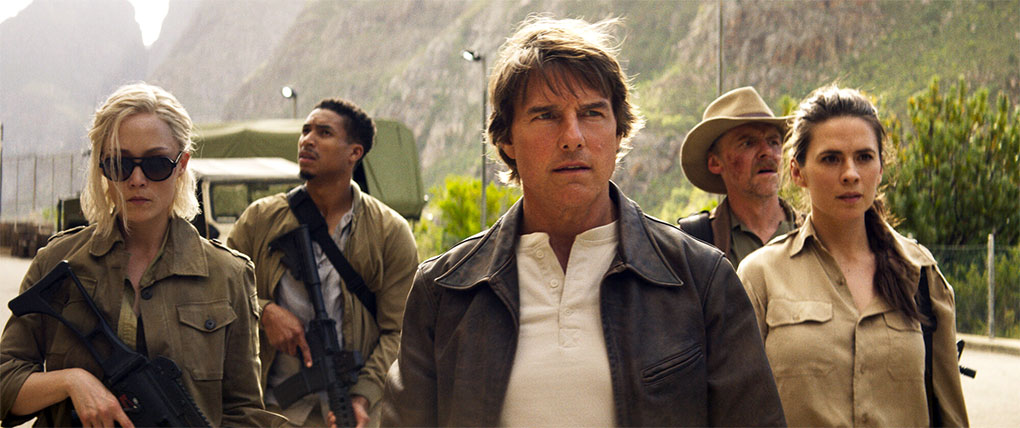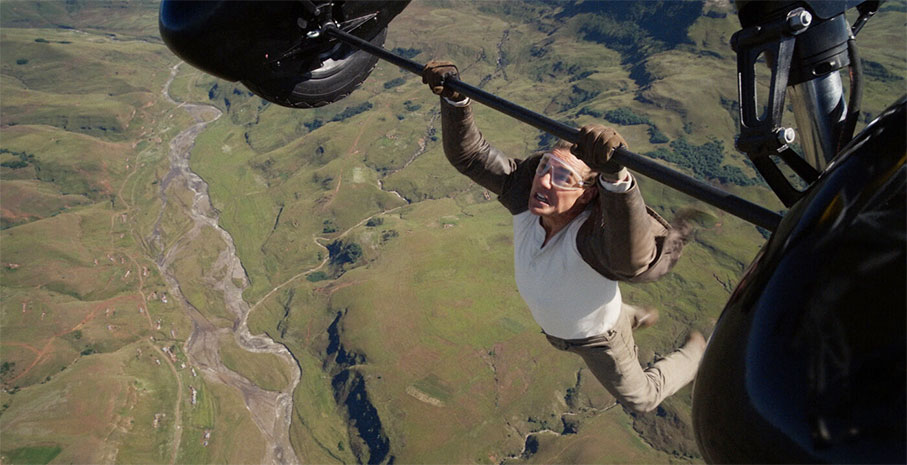| |
“In his review for The New York Times, Stephen Holden addressed the film's convoluted plot: "If that story doesn't make a shred of sense on any number of levels, so what? Neither did the television series, in which basic credibility didn't matter so long as its sci-fi popular mechanics kept up the suspense." |
| |
Review of the first Mission: Impossible taken from Wikipedia* |
| |
|
| |
“Fan service, and fandom, is poison... {on the many clips and call backs to the previous seven Mission: Impossible movies} Two things are certain to happen: One, if you know the movies, you’ve left the narrative and I have to spend precious energy bringing you back. Or you haven’t seen that other movie and you’re suddenly aware that everybody around you knows something you don’t. In either case, you’ve disrupted the narrative and broken the chain.” |
| |
Director Christopher McQuarrie** |
Having said that, there were only about 500 single figure flash frame shots of call backs from the previous seven movies in the franchise sprinkled throughout Final Reckoning. So that’s OK, right? One way to keep you in the current narrative is to flash cut your way through the ‘remember when’ shots. So a memory is activated if you’re familiar with the film series and a hyper-speed flashback is created if you’re not. Result. That’s probably the optimum way to provide the necessary narrative nostalgia and, frankly, ludicrous retconning. Perhaps the call backs were deemed necessary because of the multi-film – but one story arc – of Daniel Craig’s Bond tenure. I ask why this was necessary. Silence from the abyss. The filmmakers must have thought they were making an epic saga with distinct parts but as far as I recall with Bond, the call backs were aural rather than visual but I’m happy to stand corrected on this. Remember Blofeld being the ‘architect of all your pain’? It brought all of Craig’s Bond films into one widely sweeping arc, desperately straining at credulity. What is so wrong about creating stand-alone adventures? Every success, every event and every danger has to be retroactively linked, bolted nonsensically to some larger narrative as if this connection serves the final film and boosts its epic credentials. Why? It seems that Ethan Hunt has unwittingly engineered himself over seven movies into taking on the most dangerous mission of all (you think?) and the retrofitting and narrative clumsiness this results in just provokes sighs of “Was that all really necessary?” We could have saved some time there. But this retooling of the narrative allows the filmmakers to present Ethan Hunt as the man with a ‘destiny’ (how I hate that word except referring to a Captain Scarlet angel…) and that ‘nothing is written’ and we are masters of our own actions, la di da. Luther’s pre-taped message to Ethan at the close of the movie puts the cod in coda. So it’s only by linking all the films together can you justify the almost religious role that the messianic saviour must fulfil. Sigh.

OK, bottom line. Is it entertaining? Of course it is. Is it too long? Yes, but only by about 45 minutes. I don’t mean to be sarcastic because those 45 minutes are still entertaining but the phrase ‘too much of a good – or even wonderful – thing’ is still too much. Critics have suggested it’s the editor’s responsibility for the running length and I’m here to defend editor Eddie Hamilton. It’s his job to bring to life the director’s vision and if that vision is three hours long then there it is. Both stand out action scenes, literal high pressure stakes underwater inside a doomed submarine and high jinks on a couple of bi-planes, are way too long and the only reason I can think this is so is because of the value of their ‘authenticity’. Tom Cruise himself reminds us of this with a personal introduction to the film thanking us for pitching up to an ‘authentic cinema experience’. In other words, Tom did it all for real for us and let’s not be too concerned about precisely how it was safely achieved. But film editors sometimes have to be brutally honest with directors who’ve sweated blood to get a scene in the can and cannot bear to cut it down or heaven forbid, cut the scene altogether. The creative process demands such rigorous examination because the audience doesn’t care about the effort that went into shooting a sequence. They just want an entertaining story that makes sense. And the irony of great stunts performed for real with talent and balls galore (there’s a great Bond villain’s name for you) is that it’s like a suitcase of chocolate that you have to eat in one sitting. It’s too much even though we all appreciate the effort it took to shoot it. The filmmakers seemed to have forgotten that in smaller chunks, it’s delicious and satisfying.
At this point, I would usually attempt a synopsis and praise the various departments for their work and acknowledge the actors etc. There seems to be little point in that. Every aspect of this film is world class. You all know what this franchise attempts to deliver. So let’s just say that an evil AI (not Capone, curse typography’s capital ‘i’ looking like a lowercase ‘l’) will lay nuclear waste to the world and only one man who consistently defies orders because he always knows best, can save the day. That’s it. The craft on show is at the zenith of cinematic excellence across the board. And Hannah Waddingham’s in it! I can think of no better reason to turn up at the box office.
Ah, but then there’s the issue of credibility. It’s not exactly today’s front page news that Hollywood action films over the last 30 years have all but abandoned any shred of credibility. Heroes like James Bond and Ethan Hunt are practically invincible (OK, Bond died in Craig’s last outing, don’t nit-pick) and we all know they are going to win. The entertainment is in the how. But a human body is still a human body and for us to care it must at least be treated as one however buff the abs. Ethan gets punched very hard three times in succession in the latest film by a man three times his size with hands as wide as dinner plates. The crunch of the impact sound effects spare us – and Ethan – nothing. As Cruise rolls over and readies himself to face his opponent again, all I could think of was three shattered ribs and a burst lung, not, ‘Oh, how’s he going to get out of this one?” During this scene the pickpocket Grace reveals her advanced fighting skills taking down burly men with well-aimed kicks and punches. Did she fill the intervening daylight hours between movies in Brazilian Ju-Jitsu classes? Grace is not a secret agent. Why, here, is she now Buffy the Burly Guy Slayer? And that fight is not an isolated one. If you want another dent in credibility, something absurd passed us by, with the filmmakers hoping we don’t stop and think about it too much. It’s the almost mundane appearance of two atomic bombs the size of Mini Coopers, one in Cruise’s team’s underground London lair and the other in South Africa. OK, villains (ahem, super villains) may have great resources and the Entity (evil AI) on his side but Gabriel is never seen with a significant army of disposable bad guys, a secret infrastructure of capable bureaucrats and a bespoke FedEx account a little loose on their customs declarations. In short, this is just very, very silly. Speaking of which, fellow scribe Slarek enjoyed the very first outing of Mission in 1996 until the ‘silly climax’ and it was the first really inordinately dumb move having our hero plant an explosive on a flying helicopter while he’s standing on one of its struts. As suicide bombings go, it’s pretty ostentatious. The chewing gum detonates (explosions tend to rip anyone to pieces in milliseconds if they are anywhere near the blast location) and Ethan is a mere few feet away. Then presumably from the shock wave (!) Ethan flies through the air landing on the train in front thirty feet away unharmed. Right… And Final Reckoning is full of such ‘impossible’ silliness simply due to the fact that it’s the 8th time the filmmakers have to pull a bigger rabbit out of a bigger hat. Cruise probably called it a day thinking that only a ludicrous stunt with a real chance of death on camera will be a big enough enticing rabbit for MI:9.

There is a certain location that is a curse for action cinema and to stay ‘real’ you can’t do much about it except cut the scene as swiftly as possible to ensure the audience can still engage. That place is underwater. People move slowly underwater and you can’t speed them up. Filmmakers had quite the task making the underwater battles in the 60s Bond offering Thunderball seem remotely exciting. In Final Reckoning, Ethan has to exit a submarine, dive to another wrecked one, find his way in, navigate to a certain location as the broken hulk rocks near the very edge of an impressive precipice, open a lock with his special key, grab the box with the base code in it (don’t ask) and then get out as various areas flood dislodging missiles that impede his exit. And even though it’s intercut with his team dealing with their own problems elsewhere, the submarine sequence seems to take an eternity. It’s this scene that truly establishes Hunt as superhuman so whatever befalls him (being dragged down by a caught strap into the abyss as the sub plummets is the twelfth problem too many), he will emerge by the skin of his decompressing teeth from the freezing Arctic waters. In his boxer shorts. You sort of throw up your hands and either go with it, find it amusing or grit your teeth until the next wildly improbably sequence comes along. And that’s not far off either.
And yet… this could all just be a predictable (ahem) surface reading of a giant blockbuster, a franchise film that has to repeat itself to satisfy what executives believe people want. Something more interesting might be going on with this film and while the premise may be totally created by an enthusiastic reviewer, I couldn’t resist that notion that McQuarrie and Cruise had spent quite a lot of money examining their own industry. To read the piece by Alex Harrison of Screen Rant, please see the link in the third footnote.*** To set the idea up, he says;
“I also think Cruise and McQuarrie did something fascinating with their big franchise capstone. Together with this film's ex-part one, Dead Reckoning, they decided to make a Mission movie about Mission movies – how they're made, why they work, and what it means to make them in the age of Hollywood's IP obsession. Watch The Final Reckoning through this lens, and every bit of repetition starts to fall into place.”
His argument is wildly entertaining and while I’d love to think the filmmakers had enough self-awareness to make this subtextual reading intentional, they were probably too busy making the film to indulge themselves at that meta-level. But I urge you to read Harrison’s piece if only for some wonderful connections and surprisingly persuasive intellectual points. I’ll let Harrison have the last word.
“Because of how it explores this idea, it may not be the best Mission: Impossible movie. But it does capture what makes them so special.”
** https://www.hollywoodreporter.com/movies/movie-news/mission-impossible-8-chris-mcquarrie-fan-service-1236221346/
*** https://screenrant.com/mission-impossible-8-final-reckoning-movie-franchise-real-meaning/ |